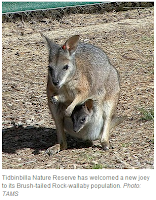Seems there is a new addition to the Tidbinbilla breeding program. This is particularly important for genetic diversity in a population so important to the re-introduction of these rare animals to the wild. Excellent news...
ACT Government TAMS media release
Released 02/12/2013

Brett McNamara, Manager of Regional Operations, National Parks and Catchments, today announced that Tidbinbilla Nature Reserve has welcomed a very special addition to its Brush-tailed Rock-wallaby population.
"Since 2010, 53 Brush-tailed Rock-wallabies have been bred at Tidbinbilla's Animal Breeding Centre, but none quite like the little joey recently born who has introduced very valuable genetics to the rock-wallaby species," Mr McNamara said.
"Low genetic variation makes a population vulnerable to inbreeding which can be detrimental to long-term reproduction rates, so it is great to see the management strategies employed by ACT Parks and Conservation now paying dividends to increase overall genetic diversity.
"The recruitment of new genes is one of these strategies, with the father of the new pouch young taken from the wild in East Gippsland, Victoria and relocated to Tidbinbilla in 2012.
"The team at Tidbinbilla has also enlisted the help of geneticists from the Southern Brush-tailed Rock-Wallaby Recovery Team to divide the wallabies into breeding groups.
"The wild male was put into a female dominated group with wallabies deemed a good mate choice based on genetics and age as well as the bond they have with the male. Now, six months later, he has sired his first joey.
"This birth is a great achievement which the team at Tidbinbilla is justifiably very proud. Last year they bred a record number of the species, with 18 born in captivity at the reserve. This is another huge step forward in ensuring the long-term survival of the overall population.
"The joey is settling in well to the beautiful surrounds of Tidbinbilla where it has plentiful food and is joined by the 10 other joeys that were bred this year."
Mr McNamara said the ACT is also playing a significant and leading part in the re-establishment of the species in Victoria.
"As part of the captive breeding program, eight wallabies bred at Tidbinbilla were released into the Grampians National Park in Victoria in 2012 and have helped improve the area's genetic diversity. Two of those we have released have now bred in the wild.
"Tidbinbilla's breeding program is part of a national effort to save the critically endangered Southern Brush-tailed Rock-wallaby species from extinction. The wallabies are locally extinct in the ACT and it is estimated there are less than 40 left in the wild – all of which reside in Victoria."
- Statement ends -
The Canberra Times has also reported the event - Baby wallaby a big step for survival
-
View Larger Map
-




 Brett McNamara, Manager of Regional Operations, National Parks and Catchments, today announced that Tidbinbilla Nature Reserve has welcomed a very special addition to its Brush-tailed Rock-wallaby population.
Brett McNamara, Manager of Regional Operations, National Parks and Catchments, today announced that Tidbinbilla Nature Reserve has welcomed a very special addition to its Brush-tailed Rock-wallaby population.







